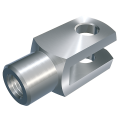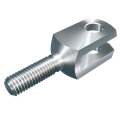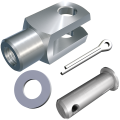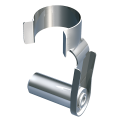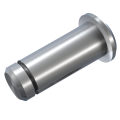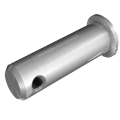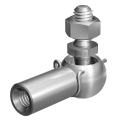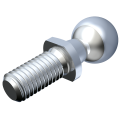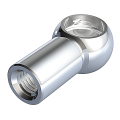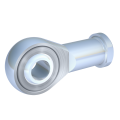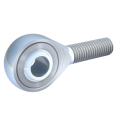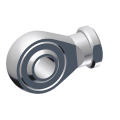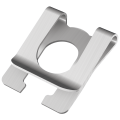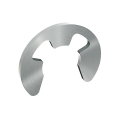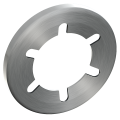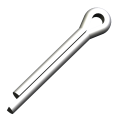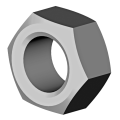描述
1. Product description
Bright key steels DIN 6880 serve as base materials for the production of machine elements such as taper keys with gip head according to DIN 6884, DIN 6887, tip hollow keys according to DIN 6889, as well as parallel keys DIN 6885 and keys according to DIN 6886.
Key steels are available in different cross-section shapes: square, rectangular, and flat-rectangular. This variety allows the raw materials to be flexibly adapted to the specific requirements of the components to be manufactured. Made from scale-free, cold-formed steel or stainless steel A4 quality, they feature a smooth, bright surface, which gives them a high dimensional accuracy – a decisive factor for precise applications. Their up to one meter long bars offer the necessary flexibility to be cut to the required dimensions.
2. Product details
Size: 2x2x1000 - 36x20x1000
Material group: Steel, stainless steel A4 quality
Surface: bright
Width b: 2 - 36
Height h: 2 - 20
Length l: 1000
3. Application Areas & Compatibility
The areas of application and compatibility of key steels DIN 6880 and the components made from it are extremely diverse, especially in technical and industrial production. Here are some areas of application and aspects of compatibility:
Areas of Application
Mechanical engineering: In general mechanical engineering, key steel and the components made from it such as taper keys with gip head and parallel keys are used to create reliable connections between rotating and stationary components. They ensure the precise transmission of torques and forces.
Industrialization in manufacturing technology: In manufacturing and machine tools, these components are central to safely connecting various mechanical parts. Especially when coupling shafts and gears, they guarantee smooth operation.
Agricultural machinery: Machine elements made of key steel are used in agricultural technology, especially in tractors and other agricultural equipment. They ensure robust connections in machines that must withstand the harsh conditions of fieldwork.
Shipbuilding: In shipbuilding, they are essential components of drive systems. They ensure the connection between engine and propeller shafts and must withstand heavy loads as well as the challenges of marine environments.
Construction: In large construction and lifting machines, such as cranes and hoists, they play a vital role in the safe transmission of forces and movements, where mechanical stability and safety are top priorities.
Compatibility
Standardized dimensions: Thanks to standardized dimensions according to DIN 6880, key steels are highly compatible with a wide variety of systems, which makes integration into machines from different manufacturers easier. This is made possible because standardized components significantly increase interchangeability and adaptability in industrial applications.
Cross-manufacturer integration: Components made from key steels are universally applicable and can be integrated into systems from various providers. This flexibility simplifies maintenance and repair, as spare parts can be easily procured and replaced without the need for modifications.
Key steels and the components derived from it are thus indispensable elements in various industries, providing not only efficiency and reliability in mechanical applications but also high adaptability to different technical systems.
4. Advantages and Benefits
High precision and dimensional accuracy: Due to standardization according to DIN 6880, key steels features high dimensional accuracy. This ensures the precise manufacturing of parts made from it, such as taper keys with gip head and parallel keys, which are used in applications with high demands on precision and safety.
Versatility: The various available cross-sections (square, rectangular, flat-rectangular) allow key steels to be used for a wide range of applications and requirements. This increases their usability and flexibility in manufacturing.
High load capacity: Key steels made from robust steel or stainless steel offer excellent strength. As a result, the resulting components are able to handle high mechanical loads, ensuring their suitability in demanding environments and applications.
Cost-effectiveness: The standardization of dimensions and the universal usability of key steels enable cost-efficient manufacturing processes. Manufacturers can produce components from key steel quickly and efficiently without additional adjustments or specialized forms.
Reliable connection solutions: Key steels allows the production of machine elements that guarantee secure, form-fit and force-fit connections. This level of reliability is essential for applications where the integrity of the connection is crucial to the overall operation of the machine.
Corrosion resistance: When using stainless steel of A4 quality as the material, key steel offers high resistance to corrosion, which extends the service life of the manufactured components, especially in demanding environments.
Benefits of key steels and the machine elements produced from it
Increased machine service life: The precise and robust connection between components helps extend the service life of machines and systems by minimizing wear and damage at important junction points.
Optimized maintenance: The overall standardized and universally applicable components simplify maintenance work, as interchangeable parts are readily available and can be used without major adjustments.
Innovative technology usage: The versatile application options promote technological innovation by enabling designers to work with customized connection solutions tailored to the specific requirements of projects.
5. Assembly and Installation
The assembly and installation of machine elements made from key steels DIN 6880, such as taper keys with gip head and parallel keys, requires precision and care to ensure reliable functionality. Here are some relevant details and steps for correct installation:
Preparations
- Inspection of parts:
Before assembly, all parts should be checked for dimensional accuracy and integrity. Make sure they are free of damage or contamination.
- Cleaning the contact surfaces:
The shaft and hub should be thoroughly cleaned to remove dirt, oil, and other contaminants. Clean contact surfaces are essential for a secure fit and a positive-locking connection.
Assembly process
- Alignment: Align the component to be installed, such as the taper key with gip head or the parallel key, with the relevant keyways in the shaft and hub. The correct fit is essential to avoid irregularities in the connection.
- Inserting the component:
Insert the component axially, ensuring it slides in evenly to avoid tilting. If necessary, slight pressure or a rubber mallet may be used to bring the part fully into position. It is important to use protective materials like plastic or wooden buffers to prevent damage.
Final inspection
- After inserting the connection parts, check whether the component sits firmly and there is no play or unwanted movement.
Subsequent inspection
- Functional test:
Test the torque transmission to ensure that the positive-locking connection works properly. This is especially important if the connection is subject to high loads.
- Regular maintenance:
Maintenance work should be performed at regular intervals to check the condition of the connections. If dimensional accuracy is lost or parts are damaged, the affected components must be replaced.
Proper assembly and care of taper keys with gip head and parallel keys not only ensures reliable functionality but also maximizes the service life of machines and components.
6. Safety instructions & Standards
When using and assembling key steels according to DIN 6880 as well as components made from it such as taper keys with gip head and parallel keys, it is important to observe relevant safety instructions and standards to ensure safe and reliable connections.
Safety Instructions
Personal protective equipment:
- Always wear suitable protective equipment, such as protective gloves and eye protection, to avoid injuries from sharp edges or when using tools.
Tool usage:
- Use appropriate tools and aids for assembly to prevent damage to the components, the shaft, or the hub. Make sure to use tools properly and in a controlled manner.
Precision and inspection:
- Before assembly, all parts should be checked for dimensional accuracy and integrity to avoid malfunctions due to mismatched or damaged components. Regular subsequent inspection of the seating and functionality is also advisable.
Handling forces:
- Ensure that the forces acting on the connection remain within the specified load limits to avoid damage to the components or the overall system.
Relevant standards
DIN 6880:
- This standard specifies the dimensions and tolerances for key steel and ensures compatibility with the corresponding groove dimensions in shafts and hubs. It serves as the basis for manufacturing the key steel and the subsequent production of the components.
DIN 6884, DIN 6887, DIN 6889, DIN 6885 and DIN 6886:
- These standards define specific dimensions and tolerances for the respective components, such as taper keys, gib head keys, and parallel keys. They ensure standardized manufacturing and interchangeability of components in various technical applications.
DIN ISO 2768:
- This standard specifies general tolerances for linear and angular dimensions, form and position, which are also relevant for the components to ensure consistent quality and compatibility during manufacturing.

